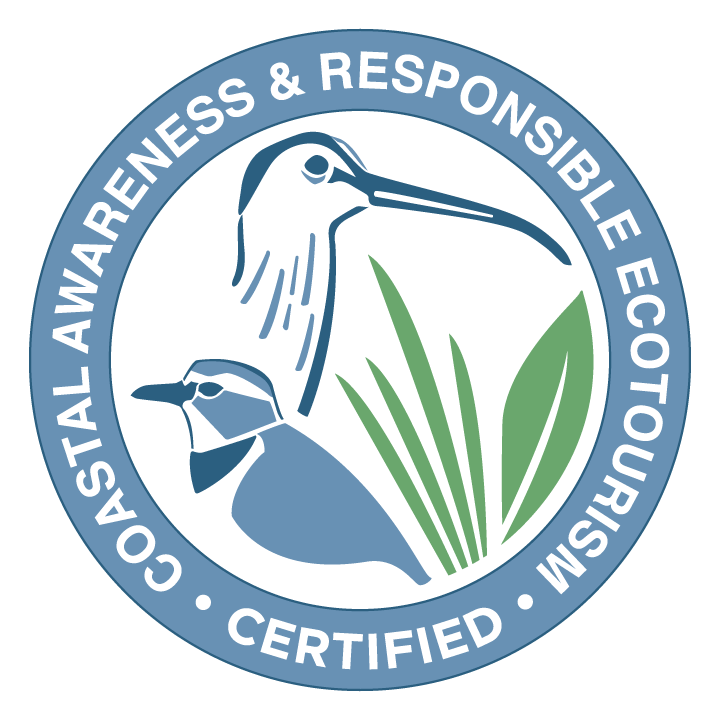Lesson 1: Oysters as a Keystone Species
| Overview | Students will develop an understanding of the oyster’s role as a keystone species. |
| Standards | SEV2. Obtain, evaluate, and communicate information to construct explanations of stability and change in Earth’s ecosystems. d. Construct an argument to support a claim about the value of biodiversity in ecosystem resilience including keystone, invasive, native, endemic, indicator, and endangered species. SEV1. Obtain, evaluate, and communicate information to investigate the flow of energy and cycling of matter within an ecosystem. a. Develop and use a model to compare and analyze the levels of biological organization including organisms, populations, communities, ecosystems, and biosphere. |
Engage
Visit to an oyster reef (field study by water) or a local living shoreline or oyster reef. During your visit have students record qualitative and quantitative observations, questions and connections. You may choose to use the prompts, “I notice, I wonder, it reminds me of….” Once back in the classroom, have students share and discuss their journal entries at their table groups. Then, lead a whole group share. Create a classroom chart (either physically or digitally) of the observations, questions and connections so that they can be referred back to throughout the unit.

If is not possible for you to visit an oyster reef, have your students observe the Georgia’s Oyster Reefs: Essential Habitat poster above. You may choose to crop the image so that the students have the opportunity to record as many observations, questions and connections before having the information explained to them. This is essential to sparking engagement during this phase of the lesson.
Explore
Biodiversity Survey
If you were able to take your students on the Oyster Reef Habitat field study by water, you will have done this in the lab at the UGA Marine Extension. If not, there are options for how you can conduct this biodiversity survey in your classroom.
Option 1: You will need clusters of freshly collected oysters. If you have access to a recreational oyster reef in your community you may be able to collect them yourself. Provide each group with a cluster of live oysters in a pan or bucket with water, along with forceps, hand lenses and petri dishes. Give students time to explore their cluster and ask them to organize the different species they find using the petri dishes. You may also want to provide access to stereo microscopes if available. Have them record the data for their sample.***If possible using the ID sheets.
Option 2: Conduct a “virtual field trip” to an oyster reef using the resource below.
Explain
Key Terms:
- Organism
- Population
- Community
- Ecosystem
- Biodiversity
- Keystone Species
- Ecosystem Engineer
Lead a group discussion about yesterday’s data collection. Feel free to use the slideshow below to guide your discussion. This discussion will help students gain the necessary vocabulary for this lesson. You may wish to have students take notes, or create a visual vocabulary for each term. At the end of the whole group discussion, students will list evidence supporting the claim that oysters are a keystone species. They will then explain their evidence to a peer. Have the students create their list in their journal or science notebook, so that they are able to refer back to them for the Evaluate portion of this lesson.
Oysters: Keystone Species Google Slide (can make a copy and edit)
Optional- Have students read the article on Keystone Species from National Geographic to determine which type of keystone species oysters are (predators, mutualists or ecosystem engineers). Have a discussion, but end letting them know that oysters are ecosystem engineers and that this would be a great term to include in their assessment that will come later in the lesson.
Elaborate
After having gone through the slideshow and having a group discussion, explain to students that scientists have different ways to measure the biodiversity of a community, and can give that community a ranking on a diversity scale. This can be very useful when monitoring one area over time. Scientists are then able to track changes in the biodiversity of that community to help determine the health of the ecosystem.
One method is to the Shannon-Wiener Biological Diversity Index. You may wish to have students complete this using the data collected yesterday. They will need access to calculators (you can use the calculator on Google).
Evaluate
In this final portion of the lesson, students will be assessed on their understanding of the biological levels of organization, as well as the value of keystone species in terms of ecosystem resilience using the claim, evidence, reasoning writing structure. If your students have not used this writing structure before, you may need to scaffold by providing examples, however if students are allowed to use their notes from the Explain portion of the lesson, that will help.
Students Instructions
Students Instructions- Google Doc (make a copy to edit)
Rubric- Google Doc (make a copy to edit)
References
Keystone species. Education. (n.d.). https://education.nationalgeographic.org/resource/keystone-species/
